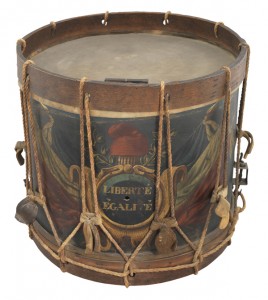Military music
Either sung or performed, military music has always been present in the armed forces. Destined to encourage the soldiers, music was an integral part of soldiers’ daily routine such as discipline  and recreation in the camp, victory celebrations and the mourning of the dead. It was also an indispensable communication tool to communicate over long distances on the battlefield amidst the deafening sound of war. Coded sequences or flow of sounds of woodwind and percussion instruments were used for keeping order in battle and infantry maneuvers.
and recreation in the camp, victory celebrations and the mourning of the dead. It was also an indispensable communication tool to communicate over long distances on the battlefield amidst the deafening sound of war. Coded sequences or flow of sounds of woodwind and percussion instruments were used for keeping order in battle and infantry maneuvers.
The Songs of the French Revolution
During the French Revolution, songs with simple, powerful and compelling lyrics became a major means of expression amongst the French people. They were written both by anonymous and professional composers formally requested to do so. In addition to La Marseillaise, there are three others.
Ah ! ça ira, ça ira, ça ira ! [Ah ! It’ll be fine, It’ll be fine, It’ll be fine !] was first sung in May 1790. The song was composed by Ladré, a former soldier who made a living as a street singer. The tune was inspired by an air written by Bécourt : The National Carillon that had become popular at the time. The title and theme of the chorus : Ah ! ça ira, ça ira, ça ira ! [Ah! It’ll be fine, It’ll be fine, It’ll be fine !] were inspired by a phrase Benjamin Franklin pronounced during the American War of Independence. This particular phrase was to become a “leitmotiv” as French revolutionaries used it against the nobility and the clergy. With time, the song underwent changes in wording : Ah ! ça ira, ça ira, ça ira ! Réjouissons-nous, le bon temps reviendra [Ah ! It’ll be fine, It’ll be fine, It’ll be fine–Let us rejoice, good times shall return] became Ah ! ça ira, ça ira, ça ira, les aristocrates à la lanterne ! Ah ! ça ira, ça ira, ça ira, les aristocrates on les pendra ! [Ah ! It’ll be fine, It’ll be fine, It’ll be fine–Aristocrats to the lamp-post–Ah ! It’ll be fine, It’ll be fine, It’ll be fine–The aristocrats, we’ll hang them !].
The Carmagnole was another anonymous chanson that became very popular. It was written in 1792 during the last days of the French Monarchy. Chorus : Dansons la carmagnole, Vive le son, Vive le son, Dansons la Carmagnole, Vive le son du canon [Let us dance the Carmagnole–Long live the sound, long live the sound–Let us dance the Carmagnole–Long live the sound of the cannons !].
Le Chant du Départ [Song of the Departure] was written as an anthem for “Liberty against Despotism”. The music was composed by Étienne Nicolas Méhul (1763-1817) and the lyrics written by Marie-Joseph Chénier (1764-1811), two renowned artists at the time. It was sung during the Battle of Fleurus in 1794.
A French Tyrtaeus
Prior to composing Le Chant de Guerre pour l’Armée du Rhin (War Song for the Army on the Rhine) that was to become La Marseillaise, Rouget de Lisle had already become a renowned figure with his Hymn of Liberty. Rouget de Lisle wrote the lyrics on a music composed by Ignace Pleyel (1757-1837). This hymn was performed on the parade grounds in Strasbourg on 25 September 1791, the day of the publication of the French Constitution of 1791. As for Le Chant de Guerre pour l’Armée du Rhin, the Strasbourg printer Philippe-Jacques Dannbach (1747-1831) published La Marseillaise in a loose-leaf format, including musical score and lyrics. Most of the songs and music were printed and sold on the streets for a small fee. It was common that people with literacy who could read music used to spread them around them.
Listen to Ha ! ça ira on Gallica
Listen to La Carmagnole on Gallica
Listen to Le chant du départ on Gallica



Ajouter un commentaire